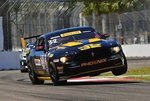For those with RE71Rs
So I am involved in both Regional Track and Autoslalom events and have been experimenting with different tire pressure setups this past season.
I've always felt the need to run higher pressures for Autoslalom vs. track to take into account temperature increases during track use.
Track: 32psi (F)/ 28psi (R) Cold
Autoslalom: 36 psi (F)/ 32psi (R) Cold
Though usually competitive in the mid-pack or 2nd place in both disciplines, the all-out "win" had been elusive this year. Until I kept my track pressures for autoslalom. On track, 32F/28R has been the most comfortable and most even temps, with hot pressures at 38F/34R between sessions.
Last weekend I topped a field of 8 CAM-C entrants (all regulars), by a margin of -3.9 sec. from the 2nd place entrant, at times holding FTD, beaten out by a Miata +0.439 secs.
I thought it may have been temperature, but its been colder as of late, and the tires still managed an even temperature across, as if I was running the higher pressures.
Have other RE71R users found this to be a sweet spot? And are there any negatives with competitive driving at pressures this low (32F/28R - both increased by only 2psi during the 50 sec. course), if temps are still even across (slightly higher on the inner fronts due to camber)?
So I am involved in both Regional Track and Autoslalom events and have been experimenting with different tire pressure setups this past season.
I've always felt the need to run higher pressures for Autoslalom vs. track to take into account temperature increases during track use.
Track: 32psi (F)/ 28psi (R) Cold
Autoslalom: 36 psi (F)/ 32psi (R) Cold
Though usually competitive in the mid-pack or 2nd place in both disciplines, the all-out "win" had been elusive this year. Until I kept my track pressures for autoslalom. On track, 32F/28R has been the most comfortable and most even temps, with hot pressures at 38F/34R between sessions.
Last weekend I topped a field of 8 CAM-C entrants (all regulars), by a margin of -3.9 sec. from the 2nd place entrant, at times holding FTD, beaten out by a Miata +0.439 secs.
I thought it may have been temperature, but its been colder as of late, and the tires still managed an even temperature across, as if I was running the higher pressures.
Have other RE71R users found this to be a sweet spot? And are there any negatives with competitive driving at pressures this low (32F/28R - both increased by only 2psi during the 50 sec. course), if temps are still even across (slightly higher on the inner fronts due to camber)?














